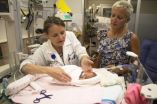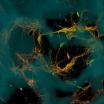(Press-News.org) DALLAS – Aug. 11, 2014 – Two years ago, the parents of Chloe Olivarez watched painfully as their daughter experienced epileptic seizures hundreds of times a day. The seizures, caused by a rare metabolic disease that depleted her brain of needed glucose, left Chloe nearly unresponsive, and slow to develop.
Within hours, treatment with an edible oil dramatically reduced the number of seizures for then-4-year-old Chloe, one of 14 participants in a small UT Southwestern Medical Center clinical trial.
"Immediately we noticed fewer seizures. From the Chloe we knew two years ago to today, this is a completely different child. She has done amazingly well," said Brandi Olivarez, Chloe's mother.
For Chloe and the other trial participants who suffer from the disease called Glut1 deficiency (G1D), seizure frequency declined significantly. Most showed a rapid increase in brain metabolism and improved neuropsychological performance, findings that suggested the oil derived from castor beans called triheptanoin, ameliorated the brain glucose-depletion associated with this genetic disorder, which is often undiagnosed.
"This study paves the way for a medical food designation for triheptanoin, thus significantly expanding therapeutic options for many patients," said Dr. Juan Pascual, Associate Professor of Neurology and Neurotherapeutics, Physiology, and Pediatrics at UT Southwestern and lead author of a study on the findings, published in JAMA Neurology.
For the estimated 38,000 Americans suffering from this disease, the only proven treatment has been a high-fat ketogenic diet, which only works for about two-thirds of patients. In addition, this diet carries long-term risks, such as development of kidney stones and metabolic abnormalities.
Based on the results of this trial, triheptanoin appears to work as efficiently as the ketogenic diet; however, more research needs to be done before the oil is made available as a medical food therapy, researchers said.
"Triheptanoin byproducts produced in the liver and also in the brain refill brain chemicals that we found are preferentially diminished in the disorder, and this effect is precisely what defines a medical food rather than a drug," said Dr. Pascual, who heads UT Southwestern's Rare Brain Disorders Program, maintains an appointment in the Eugene McDermott Center for Human Growth and Development, and holds The Once Upon a Time Foundation Professorship in Pediatric Neurologic Diseases.
The oil, approved for use in research only, is an ingredient in some cosmetic products and is added to butter in some European countries. It is not commercially available in the U.S. for clinical use.
Triheptanoin's success as an experimental treatment for other metabolic diseases, along with preclinical success in G1D mice, led Dr. Pascual and his trial collaborator, Dr. Charles Roe, Clinical Professor of Neurology and Neurotherapeutics, to first conceive the idea and then launch this trial for G1D patients. The 14 pediatric and adult patients in the study consumed varying amounts of the oil, based on their body weight, four times a day. Given the trial's success, Dr. Pascual plans further research to refine the optimal dosage toward the goal of facilitating medical food designation of triheptanoin as a new G1D treatment.
While some trial participants reported mild stomach upset as a side effect, for Chloe the oil has been a miracle medicine without negative effects. Her parents, Brandi and Josh Olivarez of Waco, Texas, continue to be amazed by her progress.
"Before, she was having so many seizures a day that she couldn't even talk. Now she sings all the time, she can eat whatever she wants, and her speech is greatly improved. She still has some learning delays, but has come a long way," said Mrs. Olivarez.
Many Glut1 patients suffer from movement disorders that limit their physical capabilities, but that does not appear to be the case with Chloe. As for the seizures, she still has minor ones occasionally, but they are not debilitating.
"She is now able to run a solid mile without stopping. This would not have been possible without the oil," Mrs. Olivarez said. "Before, she had almost no muscle tone, was lethargic and had a very wide gait due to trying to balance herself while walking, which was very tiring for her."
To better understand this disease, UT Southwestern established a patient-completed registry to track G1D incidence and what treatments work or do not work for those registered.
Study author Dr. Hanzhang Lu, Associate Professor in the Advanced Imaging Research Center and of Psychiatry and Radiology, a TI Scholar in Advanced Imaging Technologies, devised a novel MRI technique used in the trial to measure brain metabolism.
INFORMATION:
In addition to researchers from the laboratories of Dr. Pascual and Dr. Lu, other UT Southwestern researchers who contributed to this study were: Dr. Peter Stavinoha, Professor of Psychiatry; Dr. Jason Park, Assistant Professor of Pathology and in the Eugene McDermott Center for Human Growth and Development; Dr. Linda Hynan, Professor of Clinical Science and Psychiatry; and Dr. Roe. Ana Hernandez, an assessment specialist in the Department of Neuropsychology at Children's Medical Center Dallas, also contributed.
The work was supported by grants from the National Institutes of Health and unrestricted gifts from the Meyers family and the Glut1 Deficiency Foundation.
About UT Southwestern Medical Center
UT Southwestern, one of the premier academic medical centers in the nation, integrates pioneering biomedical research with exceptional clinical care and education. The institution's faculty includes many distinguished members, including six who have been awarded Nobel Prizes since 1985. Numbering more than 2,700, the faculty is responsible for groundbreaking medical advances and is committed to translating science-driven research quickly to new clinical treatments. UT Southwestern physicians provide medical care in 40 specialties to nearly 91,000 hospitalized patients and oversee more than 2 million outpatient visits a year.
Medicinal oil reduces debilitating epileptic seizures associated with Glut 1 deficiency
2014-08-11
ELSE PRESS RELEASES FROM THIS DATE:
An easier way to manipulate malaria genes
2014-08-11
Plasmodium falciparum, the parasite that causes malaria, has proven notoriously resistant to scientists' efforts to study its genetics. It can take up to a year to determine the function of a single gene, which has slowed efforts to develop new, more targeted drugs and vaccines.
MIT biological engineers have now demonstrated that a new genome-editing technique, called CRISPR, can disrupt a single parasite gene with a success rate of up to 100 percent — in a matter of weeks. This approach could enable much more rapid gene analysis and boost drug-development efforts, says ...
Kessler Foundation scientists link environment & inclusion in adults with disabilities
2014-08-11
West Orange, NJ. August 11, 2014. Kessler Foundation researchers have identified an association between the built environment and disability-related outcomes for adults with physical impairments. The article, Disability and the built environment: an investigation of community and neighborhood land uses and participation for physically impaired adults, was published in the July issue of Annals of Epidemiology (doi: 10.1016/j.annepidem.2014.05.003). The authors are Amanda Botticello, PhD, MPH, and Nicole Cobbold, BS, of Kessler Foundation, and Tanya Rohrbach, MS, of Raritan ...
A global temperature conundrum: Cooling or warming climate?
2014-08-11
MADISON, Wis. — When the Intergovernmental Panel on Climate Change recently requested a figure for its annual report, to show global temperature trends over the last 10,000 years, the University of Wisconsin-Madison's Zhengyu Liu knew that was going to be a problem.
"We have been building models and there are now robust contradictions," says Liu, a professor in the UW-Madison Center for Climatic Research. "Data from observation says global cooling. The physical model says it has to be warming."
Writing in the journal Proceedings of the National Academy of Sciences today, ...
Follow the radio waves to exomoons, UT Arlington physicists say
2014-08-11
Scientists hunting for life beyond Earth have discovered more than 1,800 planets outside our solar system, or exoplanets, in recent years, but so far, no one has been able to confirm an exomoon. Now, physicists from The University of Texas at Arlington believe following a trail of radio wave emissions may lead them to that discovery.
Their recent findings, published in the Aug. 10 issue of The Astrophysical Journal, describe radio wave emissions that result from the interaction between Jupiter's magnetic field and its moon Io. They suggest using detailed calculations about ...
Digoxin tied to increased risk of death in patients with atrial fibrillation
2014-08-11
In An Account of the Foxglove and Some of its Medical Uses, published in 1785, Sir William Withering cautioned readers that extracts from the plant foxglove, also called digitalis, was not a perfect drug. "Time will fix the real value upon this discovery," he wrote.
Now, more than 200 years later, researchers at the Stanford University School of Medicine have validated Withering's warning with the discovery that patients with atrial fibrillation — a rapid and irregular heart rhythm — who are treated with the digitalis-derivative digoxin are more likely to die than similar ...
Bioengineers make functional 3-D brain-like tissue model
2014-08-11
MEDFORD/SOMERVILLE, Mass. (August 11, 2014) --The human brain remains one of the least understood organs in the human body, because of its complexity and the difficulty of studying its physiology in the living body. Tufts University researchers today announced development of the first reported complex three-dimensional model made of brain-like cortical tissue that exhibits biochemical and electrophysiological responses and can function in the laboratory for months. The engineered tissue model offers new options for studying brain function, disease and trauma, and treatment. ...
Trapped atmospheric waves triggered more weather extremes
2014-08-11
It has been linked to a recently discovered mechanism: the trapping of giant waves in the atmosphere. A new data analysis now shows that such wave-trapping events are indeed on the rise.
"The large number of recent high-impact extreme weather events has struck and puzzled us," says Dim Coumou, lead author of the study conducted by a team of scientists from the Potsdam Institute for Climate Impact Research (PIK). "Of course we are warming our atmosphere by emitting CO2 from fossil fuels, but the increase in devastating heat waves in regions like Europe or the US seems ...
Preemies' gut bacteria may depend more on gestational age than environment
2014-08-11
Scientists believe babies are born with digestive systems containing few or no bacteria. Their guts then quickly become colonized by microbes — good and bad — as they nurse or take bottles, receive medication and even as they are passed from one adoring relative to another.
However, in infants born prematurely, researchers at Washington University School of Medicine in St. Louis have found that the population of bacteria in babies' gastrointestinal tracts may depend more on their biological makeup and gestational age at birth than on environmental factors. The scientists ...
Bioengineers create functional 3-D brain-like tissue
2014-08-11
Bioengineers have created three-dimensional brain-like tissue that functions like and has structural features similar to tissue in the rat brain and that can be kept alive in the lab for more than two months.
As a first demonstration of its potential, researchers used the brain-like tissue to study chemical and electrical changes that occur immediately following traumatic brain injury and, in a separate experiment, changes that occur in response to a drug. The tissue could provide a superior model for studying normal brain function as well as injury and disease, and ...
Scientists demonstrate long-sought drug candidate can halt tumor growth
2014-08-11
LA JOLLA, CA – August 11, 2014 – It's a trick any cat burglar knows: to open a locked door, slide a credit card past the latch.
Scientists at The Scripps Research Institute (TSRI) tried a similar strategy when they attempted to disrupt the function of MYC, a cancer regulator thought to be "undruggable." The researchers found that a credit card-like molecule they developed somehow moves in and disrupts the critical interactions between MYC and its binding partner.
The research, published the week of August 11 in the journal Proceedings of the National Academy of Sciences, ...






